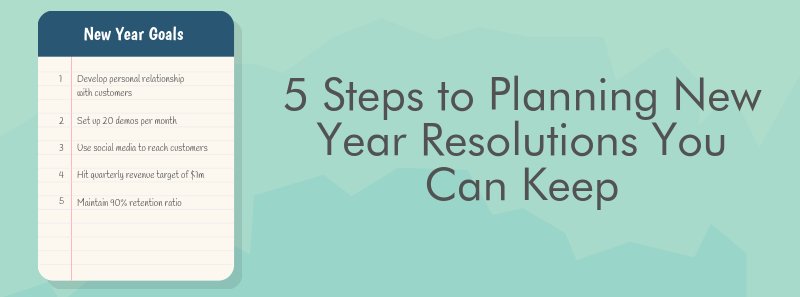With 2016 just around the corner, it’s time again for us to plan new goals to make it even better than the last. Without some serious planning, however, goals can be insurmountable challenges once the allure of the reward gives way to the comfort of our deeply-set routines. With the right plan, an appropriate amount of time, and commitment, though, even the toughest goals can be just another line on an endless list of accomplishments.
To help you break down tough goals into a bulletproof plan for accomplishing them, we’ve put together a short blueprint for success from various resources. Though the accompanying examples are written with sales professionals in mind, the blueprint works for anyone that wants to accomplish big things in 2016. We hope you find it useful!
-
Visualize what you want to accomplish:
-
Break down big goals into smaller ones:
-
Create a schedule and prioritize when necessary:
-
Hold yourself accountable:
-
Reward yourself:
The first step to setting an achievable goal, according to Brian Tracy, author of the book Goals, is to visualize in great detail exactly what you aim to accomplish. In this case, 12 months from now, where do you see yourself? A sales professional might aim to close 30% more revenue than in 2015, to build out reports that let them see team performance, or to improve the alignment between marketing and sales strategy.
Breaking long term goals into smaller actionable tasks that can be achieved in a shorter span of time can make them seem more achievable, and help you track progress. For example, if your goal is to close 20% more deals in 2016, break it into a monthly quantity of leads. Then, extrapolate that to how many cold calls you might have to make per month, week, and day based on your current cold call conversion rate. At the end of each period, measure how close you were to accomplishing your sub-goal, and adjust your strategy from there.
Shark Tank’s Robert Hejavec often says that “a goal without a timeline is just a dream”. By breaking goals down into monthly, weekly, and daily sub-goals, you’re all set to make that schedule. After all, life won’t stop just because you’ve decided to make a change. Scheduling time to work on your goals ensures that non-priorities that are “easy” to do don’t get in the way of goals that are challenging but much more impactful.
It happens to the best of us – sooner or later you’ll find an excuse to renege on your commitment to improvement. A common feeling is that you deserve a little break after everything that you’ve accomplished so far, and that you’ll pick up right where you left off after the break. Typically, however, once the chain of success is broken it’s very hard to get back on track with your goal because it feels just like starting over, so it’s important to get people to help you stay accountable. An excellent way to do this is to involve other people that have your best interests in mind. A good friend of mine often asks co-workers or friends to keep track of his progress, and in exchange for their time tracking him, if he fails to finish what he set out to do he has to buy them dinner at a fancy restaurant. A bonus is that this is an excellent way to strengthen relationships, too!
Creating a well defined and rewarded path to accomplishing our goals, much like a video game does as you work through the levels, can help us get there with more gusto. Video games keep players engaged by rewarding them with loot when they accomplish some difficult task along the path to beating the final boss. By rewarding ourselves along the way whenever we hit a key milestone, we become more energized to make it to the end of our mission.
Used together, the above blueprint can help you set yourself up for a productive 2016, which we hope you kick with renewed ambition, drive, and success. From all of us here at Vtiger – Happy New Year!



